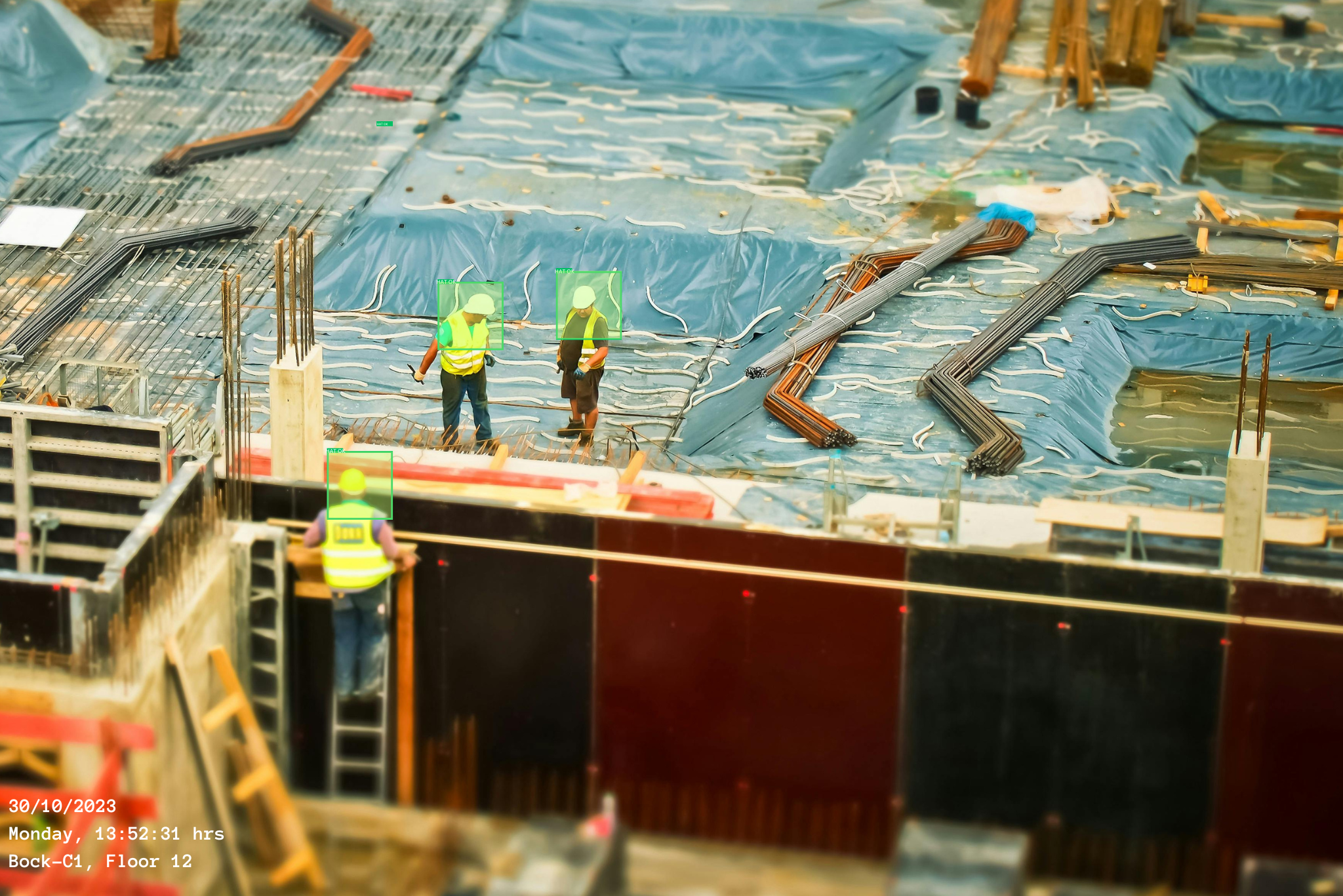Need a Hard Hat Compliance Solution? Vision AI is here to Deliver the Perfect Solution

See It In Action

Hard Hat Compliance in Construction
See how Vision AI detects hard hat violations in real-time
Example Videos
Hard Hat Compliance in Construction
See how Vision AI detects hard hat violations in real-time
Hard Hat Compliance in Manufacturing
Vision AI PPE Compliance for Manufacturing
Key Takeaways
- Automated Detection: Vision AI uses cameras and algorithms to continuously monitor hard hat usage
- Real-Time Alerts: Instant notifications when violations occur enable immediate intervention
- Comprehensive Coverage: 24/7 monitoring across all areas ensures no compliance gaps
- Data-Driven Insights: Analytics identify patterns and predict potential compliance issues
- Reduced Costs: Automated monitoring decreases the need for manual safety inspections
The Critical Importance of Hard Hat Compliance
Hard hats represent one of the most fundamental safety requirements in high-risk industries like construction, manufacturing, and mining. These seemingly simple protective devices prevent countless serious injuries and fatalities each year by protecting workers from falling objects, electrical hazards, and impact injuries.
Despite their importance, ensuring consistent hard hat usage remains a significant challenge for safety managers. Workers may remove hard hats due to discomfort, forget to wear them in certain areas, or simply become complacent about safety requirements over time. This inconsistent compliance creates serious safety risks and potential regulatory violations.
 Hard hats are essential PPE in construction and other high-risk environments
Hard hats are essential PPE in construction and other high-risk environments
The Limitations of Traditional Compliance Monitoring
Traditional approaches to hard hat compliance rely heavily on manual observation and enforcement. Safety managers and supervisors conduct periodic walkthroughs, checking for proper PPE usage and addressing violations as they're observed. While this approach has been standard practice for decades, it comes with significant limitations:
Human Observation Constraints
- Limited Coverage: Supervisors can only monitor a small portion of the worksite at any given time
- Inconsistent Enforcement: Different supervisors may have varying standards for compliance
- Inspection Fatigue: The effectiveness of manual monitoring decreases over time due to observer fatigue
- Predictable Patterns: Workers may comply only during expected inspection times
Resource Intensive Requirements
- Labor Costs: Dedicating staff to safety monitoring diverts resources from other critical tasks
- Documentation Challenges: Manual tracking of violations and compliance is time-consuming
- Training Needs: Ensuring consistent enforcement requires extensive supervisor training
- Reactive Approach: Issues are addressed only after they're observed, often too late
These limitations create an environment where compliance becomes inconsistent, putting workers at risk and exposing organizations to potential regulatory penalties and liability.
How Vision AI Transforms Hard Hat Compliance
Vision AI represents a revolutionary approach to hard hat compliance monitoring by leveraging advanced computer vision and machine learning technologies. This system uses standard security cameras combined with sophisticated algorithms to automatically detect whether workers are wearing appropriate head protection.
Automated Detection Capabilities
The core of Vision AI's hard hat compliance solution is its ability to automatically identify proper PPE usage:
- Object Recognition: Advanced algorithms identify hard hats of various types and colors
- Contextual Analysis: The system understands different zones and their specific PPE requirements
- Multiple Camera Integration: Comprehensive coverage across the entire facility
- Continuous Learning: The system improves accuracy over time through machine learning
This automated approach ensures consistent monitoring without the limitations of human observation, creating a more reliable compliance system.
 Vision AI automatically detects whether workers are wearing required hard hats
Vision AI automatically detects whether workers are wearing required hard hats
Real-Time Monitoring and Alerts
Unlike periodic manual inspections, Vision AI provides continuous monitoring with immediate response capabilities:
- 24/7 Surveillance: Constant monitoring across all shifts and locations
- Instant Notifications: Alerts sent to supervisors the moment a violation is detected
- Customizable Alert Routing: Notifications directed to the appropriate personnel based on location
- Escalation Protocols: Automated escalation for unaddressed violations
This real-time capability transforms compliance from a periodic check to a continuous safety system, dramatically reducing the time workers spend without proper protection.
Comprehensive Data Collection and Analytics
Beyond immediate detection, Vision AI creates a rich dataset that enables deeper insights into compliance patterns:
- Compliance Trends: Identification of times, locations, or teams with higher violation rates
- Historical Comparisons: Tracking improvement over time as interventions are implemented
- Predictive Analytics: Forecasting potential compliance issues based on historical patterns
- Root Cause Analysis: Identifying underlying factors contributing to non-compliance
These analytics transform safety management from reactive enforcement to proactive improvement, addressing the root causes of non-compliance rather than just the symptoms.
Practical Implementation and Results
Organizations implementing Vision AI for hard hat compliance typically follow a straightforward deployment process:
- Assessment: Evaluation of existing camera infrastructure and compliance challenges
- Installation: Integration of Vision AI software with camera systems
- Configuration: Customization of detection parameters and alert protocols
- Training: Brief orientation for safety personnel on system operation
- Monitoring: Continuous improvement through feedback and adjustment
The results of Vision AI implementation are typically significant and measurable:
- Compliance Improvement: Organizations typically see 30-50% reduction in hard hat violations
- Incident Reduction: Corresponding decrease in head injury incidents
- Resource Efficiency: 70-80% reduction in time spent on manual compliance monitoring
- Cultural Impact: Enhanced safety awareness across the organization
These outcomes demonstrate the transformative impact of Vision AI on hard hat compliance and overall safety culture.
Beyond Basic Compliance: Additional Benefits
While improved hard hat compliance is the primary goal, Vision AI delivers several additional benefits that enhance overall safety and operational efficiency:
Enhanced Safety Culture
- Consistent Enforcement: Uniform application of safety standards builds trust in the system
- Objective Monitoring: Removes perception of selective enforcement or favoritism
- Visible Commitment: Demonstrates organizational investment in worker safety
- Data-Driven Discussions: Enables fact-based conversations about safety improvement
Operational Advantages
- Reduced Downtime: Fewer injuries mean less operational disruption
- Lower Insurance Costs: Improved safety records can reduce insurance premiums
- Regulatory Compliance: Comprehensive documentation for regulatory inspections
- Resource Optimization: Safety personnel can focus on improvement rather than monitoring
Expandable Platform
- Additional PPE Detection: The same system can monitor for safety glasses, gloves, and vests
- Behavior Monitoring: Detection of unsafe actions beyond PPE compliance
- Zone Management: Enforcement of restricted area protocols
- Integration Capabilities: Connection with other safety and operational systems
This multifaceted value proposition makes Vision AI an increasingly essential component of modern safety management systems.
Implementation Considerations
Organizations considering Vision AI for hard hat compliance should evaluate several factors to ensure successful deployment:
Technical Requirements
- Camera Coverage: Ensuring adequate visual coverage of work areas
- Lighting Conditions: Assessing and potentially improving lighting in monitored areas
- Network Infrastructure: Confirming sufficient bandwidth for video processing
- Integration Points: Identifying connections with existing safety management systems
Organizational Factors
- Communication Strategy: Explaining the system's purpose and operation to the workforce
- Privacy Considerations: Addressing worker concerns about surveillance
- Response Protocols: Establishing clear procedures for addressing detected violations
- Success Metrics: Defining how system effectiveness will be measured
Addressing these considerations proactively helps ensure a smooth implementation and maximum value from the Vision AI system.
Conclusion: The Future of Hard Hat Compliance
Vision AI represents the future of hard hat compliance monitoring, offering a level of consistency, coverage, and insight that traditional methods simply cannot match. By automating the detection process, providing real-time alerts, and generating valuable compliance data, these systems transform safety management from a reactive, resource-intensive process to a proactive, efficient system.
As workplace safety standards continue to evolve and labor resources become increasingly constrained, Vision AI provides a scalable, reliable solution to the persistent challenge of PPE compliance. Organizations that implement these systems not only enhance worker protection but also demonstrate their commitment to leveraging innovative technologies for safety improvement.
For safety-conscious organizations looking to enhance hard hat compliance while optimizing resources, Vision AI offers the ideal combination of technological sophistication and practical application—truly delivering the perfect solution to a critical safety challenge.
Ready to transform your hard hat compliance monitoring with Vision AI? Contact Visionify today to schedule a demonstration and discover how our solutions can enhance safety while reducing the burden of manual inspections.
Frequently Asked Questions
Find answers to common questions about this topic
Want to learn more?
Discover how our Vision AI safety solutions can transform your workplace safety.
Schedule a DemoSchedule a Meeting
Book a personalized demo with our product specialists to see how our AI safety solutions can work for your business.
Choose a convenient time
Select from available slots in your timezone
30-minute consultation
Brief but comprehensive overview of our solutions
Meet our product experts
Get answers to your specific questions
Related Articles
Subscribe to our newsletter
Get the latest safety insights and updates delivered to your inbox.


